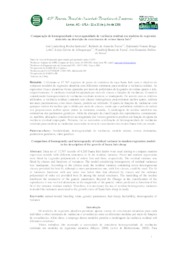Comparação de homogeneidade e heteroneneidade de variância residual em modelos de regressão aleatória na descrição do crescimento de ovinos Santa Inês.
Comparação de homogeneidade e heteroneneidade de variância residual em modelos de regressão aleatória na descrição do crescimento de ovinos Santa Inês.
Author(s): SARMENTO, J. L. R.; TORRES, R. de A.; LOBO, R. N. B.; ALBUQUERQUE, L. G. de; SOUSA, W. H. de; SOUSA, J. E. R. de
Summary: Resumo: Utilizaram-se 17.767 registros de pesos de cordeiros da raça Santa Inês com o objetivo de comparar modelos de regressão aleatória com diferentes estruturas para modelar a variância residual. As regressões fixas e aleatórias foram ajustadas por meio de polinômios de Legendre de ordens quatro e três, respectivamente. A variância residual foi ajustada por meio de classes e funções de variâncias. O modelo considerando homogeneidade de variâncias residuais mostrou-se inadequado. De acordo com os critérios utilizados, a variância residual contendo sete classes heterogêneas proporcionou melhor ajuste, embora um mais parcimonioso, com cinco classes, poderia ser utilizado. O ajuste de funções de variâncias com qualquer ordem foi melhor que o obtido por meio de classes, sendo que o polinômio ordinário de ordem seis proporcionou melhor ajuste dentre as estruturas testadas. A modelagem do resíduo interferiu nas estimativas dos parâmetros genéticos. Além da alteração da classificação dos reprodutores, constataramse, também, alterações consideráveis na magnitude dos valores genéticos preditos em função do ajuste da variância residual empregado. Portanto, faz-se necessário a utilização de heterogeneidade de variâncias residuais para modelar as variâncias associadas à curva de crescimento dos ovinos Santa Inês em estudo. Comparison of homogeneity and heterogeneity of residual variance in random regression models in the description of the growth of Santa Inês sheep]. Abstract: Data set of 17,767 records of 4,210 Santa Inês lambs were used aiming to compare random regression models with different structures to fit the residual variance. Fixed and random regressions were fitted by Legendre polynomials of orders four and three, respectively. The residual variance was fitted by classes and functions of variances. The model considering homogeneity of residual variances was inadequate. According to the criteria used, the residual variance containing seven heterogeneous classes provided the best fit, although a more parsimonious one, with five classes, could be used. The fit of variances functions with any order was better than that obtained by classes and the ordinary polynomial of order six provided best fit among the tested structures. The modelling of the residue interfered the estimative of the genetic parameters. Beyond the Change in the classification of the reproducers it was verified alterations in the magnitude of the genetic values predicted as function of the fit of the variance residual studied. Therefore, it is necessary the use of residual heterogeneity variances to model the variances associated to the growth curve of Santa Inês sheep in study.
Publication year: 2008
Types of publication: Paper in annals and proceedings
Unit: Embrapa Goats & Sheep
Observation
Some of Embrapa's publications are published as ePub files. To read them, use or download one of the following free software options to your computer or mobile device. Android: Google Play Books; IOS: iBooks; Windows and Linux: Calibre.
Access other publications
Access the Agricultural Research Database (BDPA) to consult Embrapa's full library collection and records.
Visit Embrapa Bookstore to purchase books and other publications sold by Embrapa.

